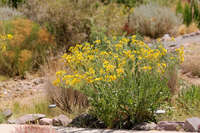Perennials, 20-50(-100) cm (taproots or caudices becoming woody). Stems erect (coarsely strigose, hispid, or hirsute), usually branched (at least distally, sometimes branched from bases, aerial stems multiple). Leaves basal and cauline; alternate; petiolate (basal and proximal cauline) or sessile (distal); blades (pinnately nerved) mostly oblong to lanceolate, usually 1(-2)-pinnately lobed, bases ± cuneate, ultimate margins entire, faces coarsely strigose, hispid, or hirsute. Heads radiate, in open, corymbiform arrays. Involucres hemispheric, 6-10 mm diam. Phyllaries persistent (outer) or falling (inner, with cypselae), mostly 18-24+ in ± 3 series (outer with relatively short, expanded, indurate bases and longer, linear, herbaceous tips, inner broadly ovate, mostly indurate, scarious-margined, herbaceous tips relatively broader and shorter, tending to split along midveins in age). Receptacles flat, paleate (paleae linear to narrowly oblong, hirsute-ciliate at tips). Ray florets 8-9 (each subtended by an inner phyllary), pistillate, fertile; corollas yellow (laminae oblong-elliptic, entire or minutely 2-3-toothed). Disc florets 25-50, functionally staminate; corollas yellow, tubes shorter than campanulate throats, lobes 5, ± deltate (anthers black, appendages deltate, obtuse; styles not branched). Cypselae obcompressed or obflattened, obovate (each falling with subtending phyllary, 2-4, indurate paleae, plus sterile ovaries of 2-4 disc florets, margins ± ciliate, faces strigose to pilose); pappi persistent or tardily falling, of 2-4, ciliate scales. x = 9.




